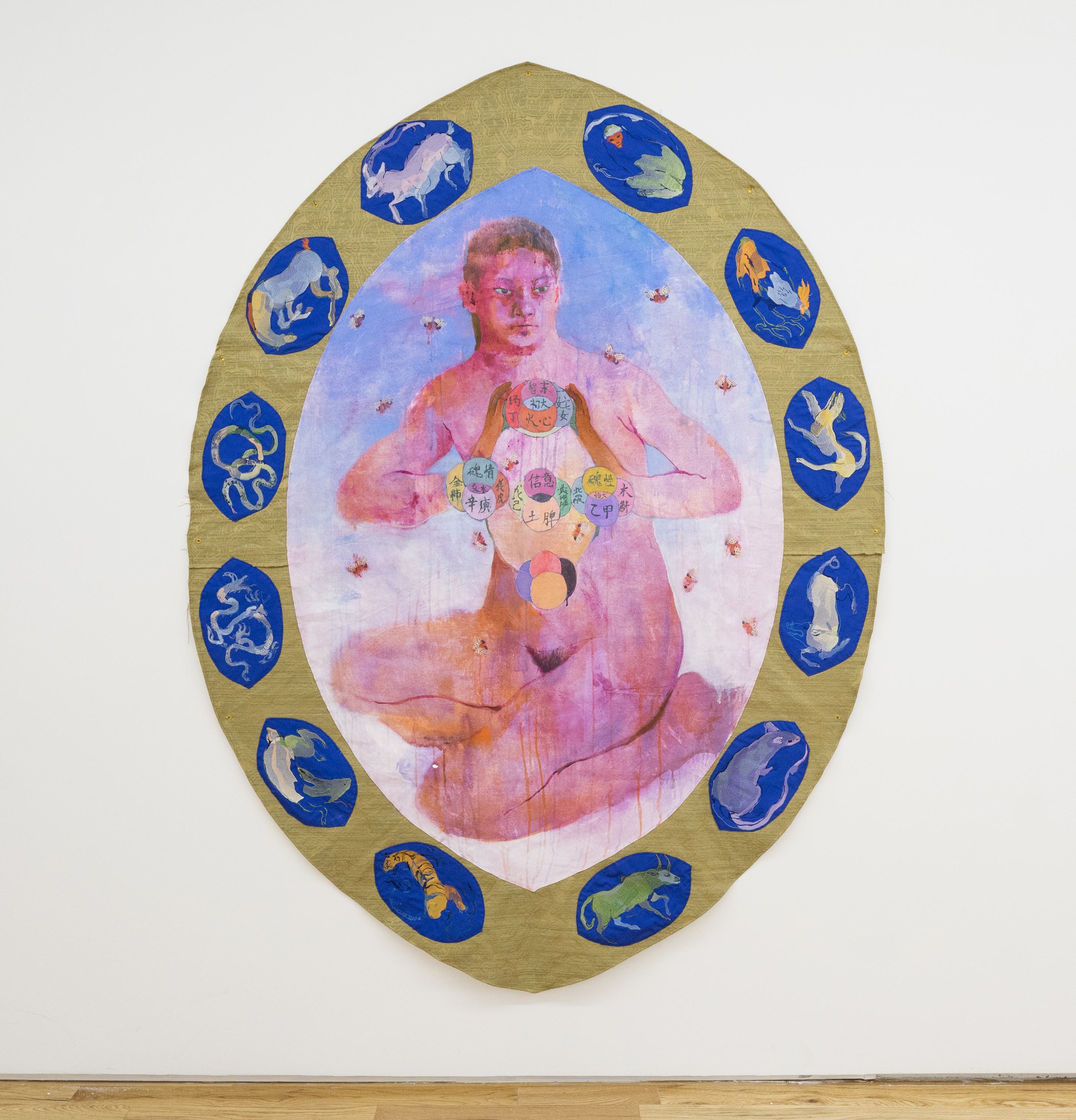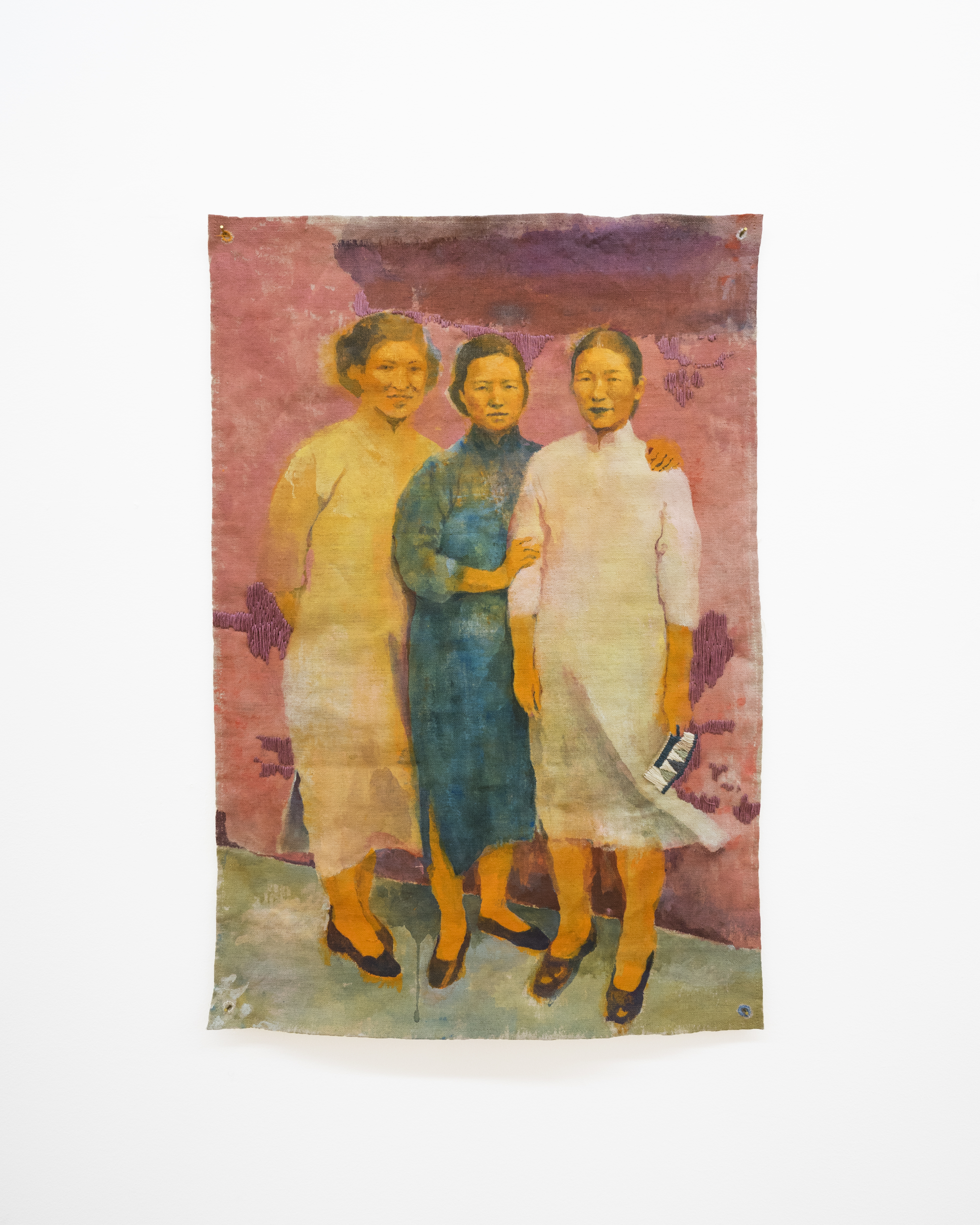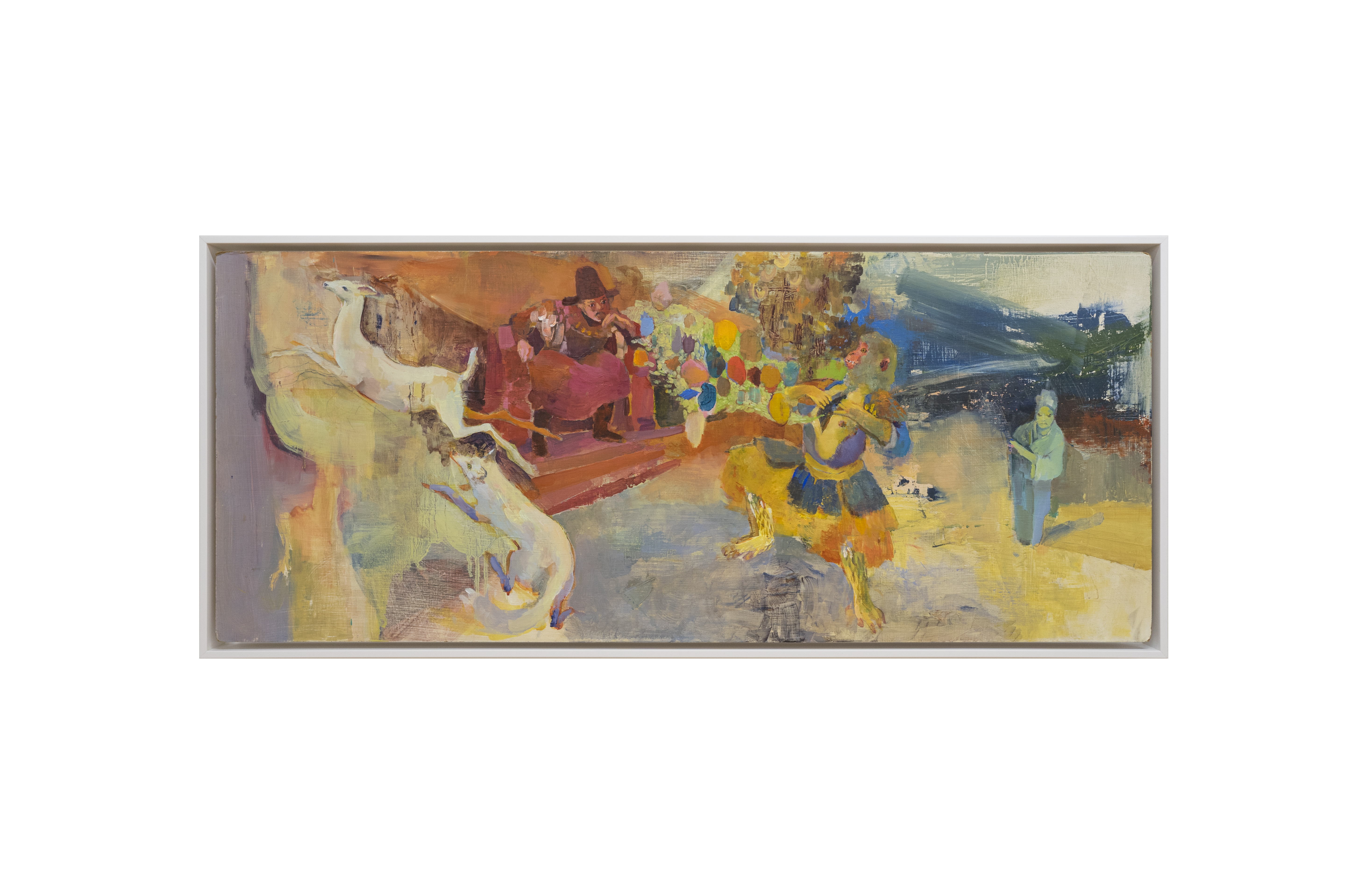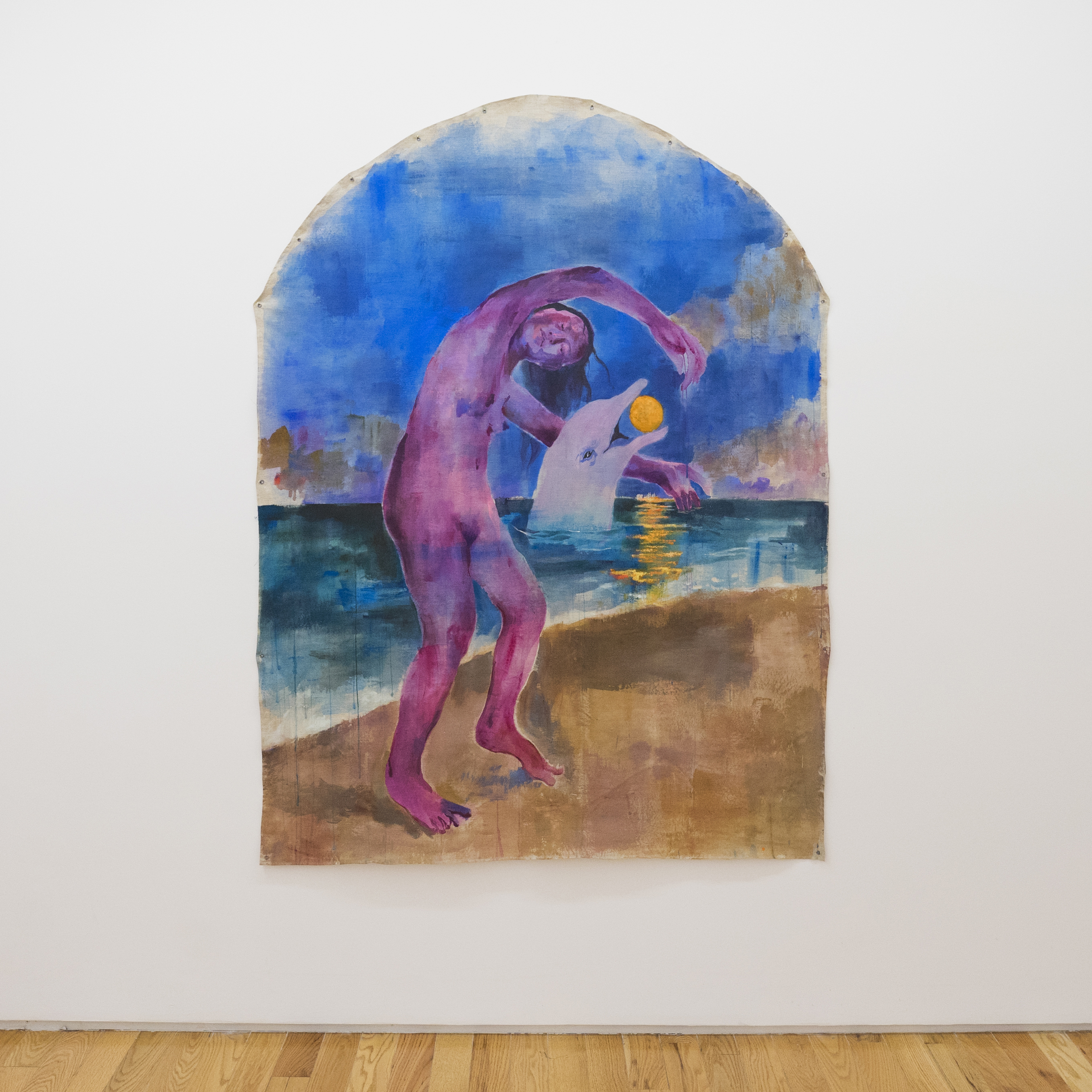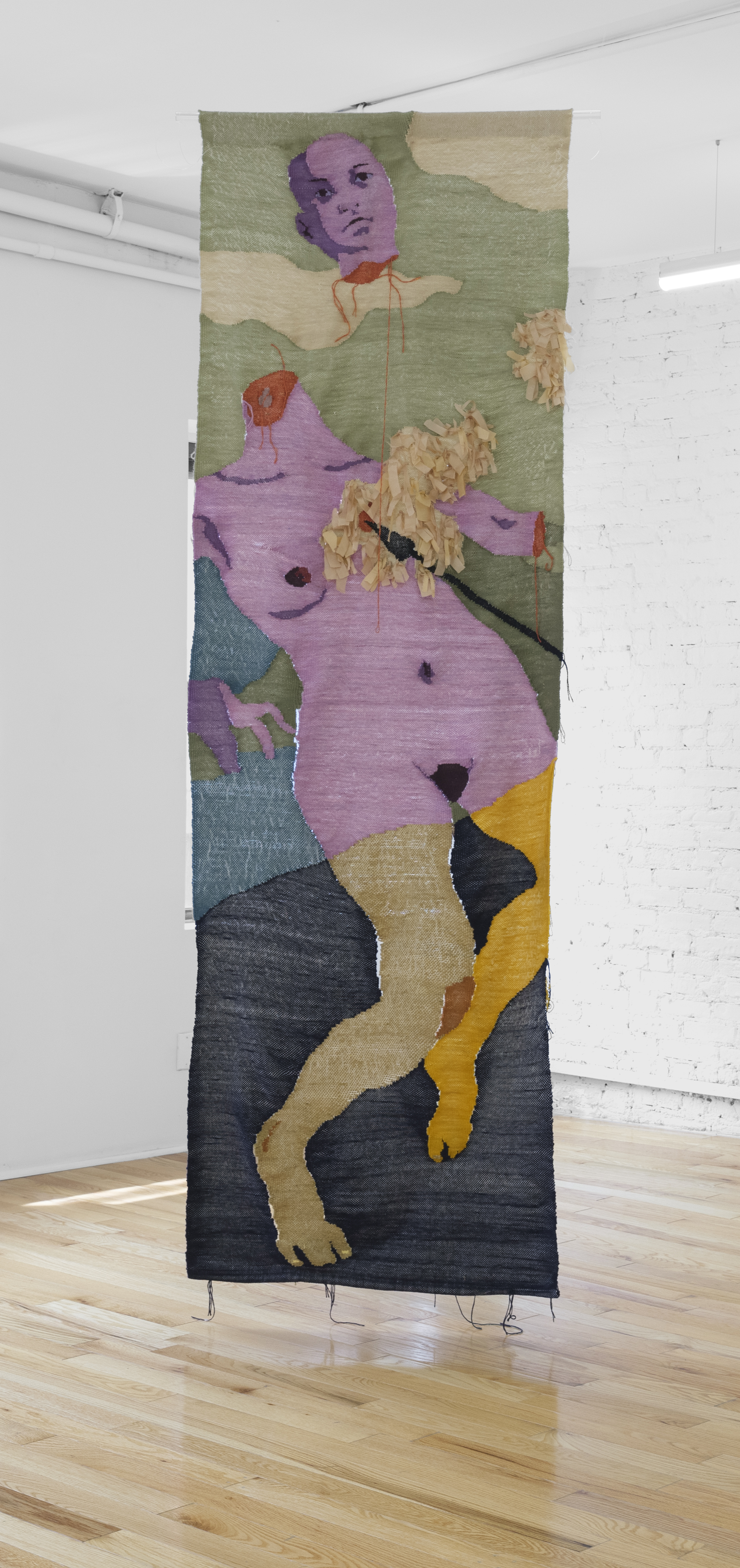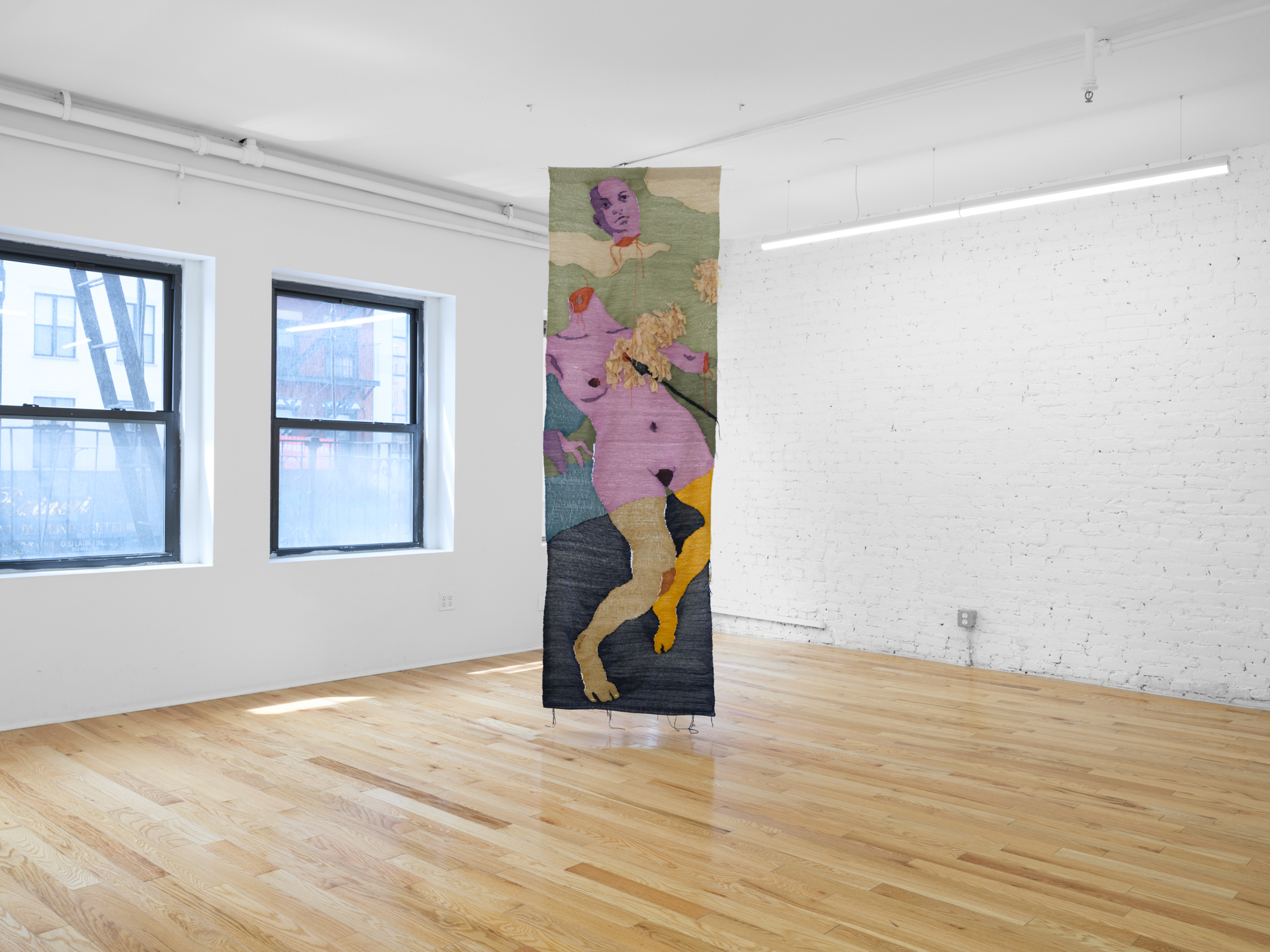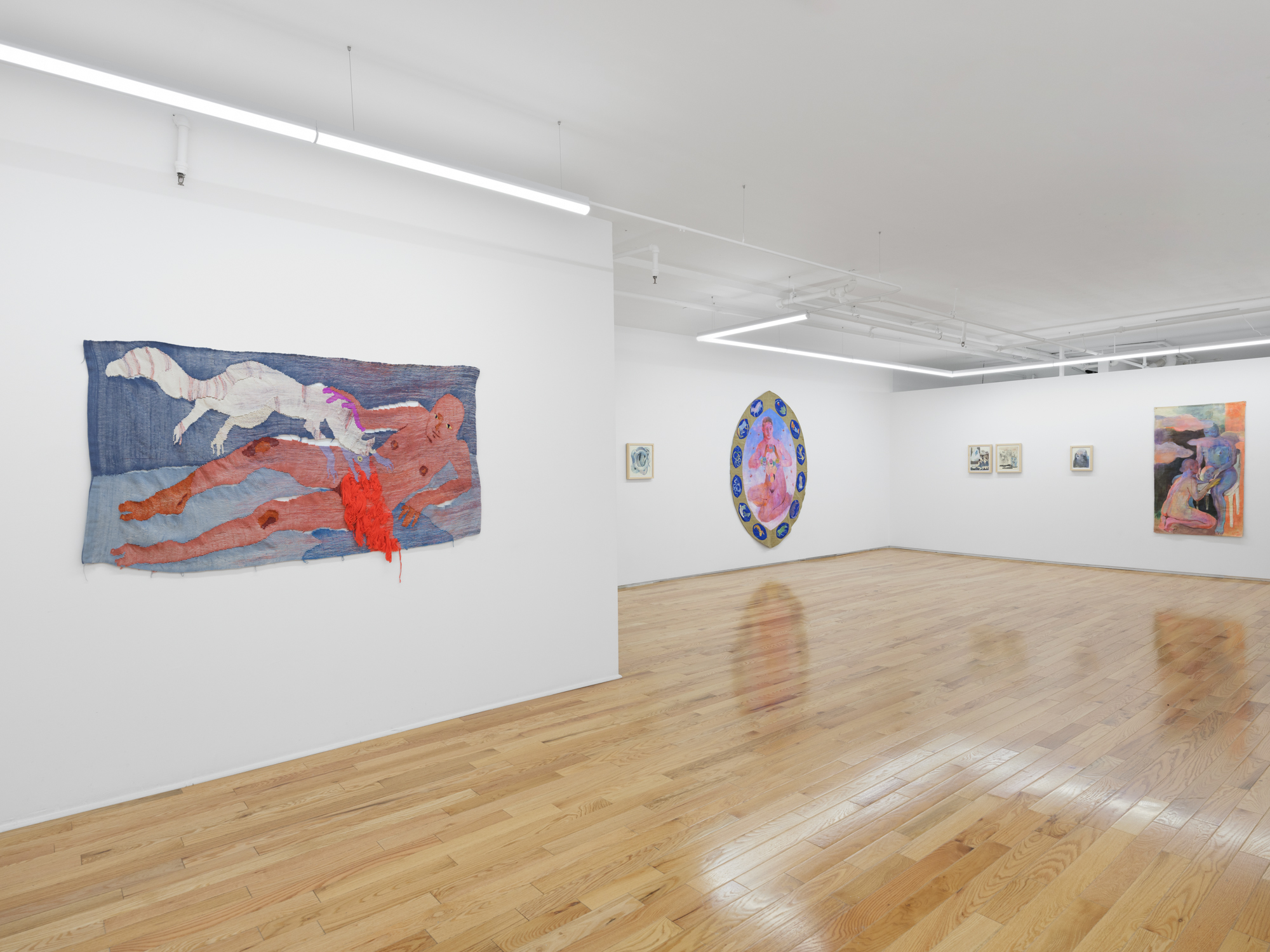formerly: Rubber Factory
full archive here
full archive here
The Tree of Heaven Falls is New York-based artist Jia Sung’s (b. 1992, Minnesota) first solo presentation with Island Gallery, NYC. For this exhibition, the artist assembles a new body of work across painting and large-scale textile.
Core to the exhibition’s new works and undertaking the same name, the painted textile Tree of Heaven (Lineage) recalls from personal memory a tree of heaven (called 臭椿 or stinktree in Chinese, taxonomically Ailanthus altissima from the Ambonese word ailanto, meaning ‘tree that reaches for the sky), being removed by the NYC arborist department because it was said to harbor lanternfly eggs. Brought over during the chinoiserie boom of the 1700’s, the species was originally imported as a specimen of decorative beauty and planted widely on the street. Now considered an invasive species, its botanist-christened nickname the Tree of Hell (also the title of another work in the exhibition that features olive tree groves burning in Palestine) denotes its ability to rapidly grow and resprout when cut. In the American immigrant novel A Tree Grows in Brooklyn however, the tree becomes a symbol of perseverance. Along with Jessica Hernandez’s writing on formative Native ideas around invasive species where “we acknowledge them as displaced relatives, rather than invasive species, since at the end of the day they are still someone’s relatives,” Sung renders the tree of heaven nobly as its own subject on an embroidered banner, which becomes evocative of a family tree that features faces of the artist’s own ancestral lineage embedded into its robust trunk.
Accompanying select pieces from the series Chaos, Whims, Lust (2019) take the Chinese allegorical classic Journey to the West and reimagines it as a narrative of sisterhood, matriarchy, and rebellion. As Sung does through much of her practice, a traditional text of patriarchal and often puritanical underpinnings is recast to examine the noted absence of female tricksters in mythology. By weaving such figures into her material worldbuilding, these monstrous, chimeric animal-women become kin. In this way, Sung also draws on the problematic aspects of canonical narratives without romanticizing its tropes, creating alternative narratives that focus on familial archives and love between women within an ecological and interspecies lineage. In this vein, Sung’s practice expands on motifs and nonhuman beings from folklore, further drawing across various aesthetic traditions including zodiacs, Daoist medical diagrams, to medieval European imagery. Her eco-feminist approach also notably references that of the zhiguai tradition or the genre of “strange tales”, where the supernatural, spiritual, abject, and uncanny seep into the tidy confines of ordinary existence. Through this framework, shapeshifter and trickster figures inhabit liminal pictorial spaces and refuse to be held in place or form, wilderness enters the domestic space and vice versa, where creatures also refute taxonomy.
In addition to the notion of invasive species as a powerful metaphor of resilience for the immigrant experience, of both human and nonhuman kin displaced across geographies, “nature” as a mirror for understanding the self through “otherness” emerges as a throughline in Sung’s new work such as Supermoon July and Revelation (Mirror). As the artist notes, “we narrativize ourselves through conceptualizing an Other, but the Other disobeys, shapeshifts, evolves continually.” By significantly thinking through colonial definitions of “otherness” as a reduction of “nature” into inert, exploitable objects, or bodies for labor, Sung provides portals of possibility into a kind of alterity––or the diversity (including biodiversity) found in difference and even a radically heterogeneous otherness. In Zodiac Man and Wound That Bears Fruit, out of bodily wounds burst forth scabs in the form of lantern flies and fruiting flesh that represent new possibilities, ways of being, and pathways through loss or trauma. In Trickster Makes This World, Lewis Hyde relays the Tsimshian story of Raven, who is introduced to the cyclical nature of mortality by being taught to ingest their own scabs, an image that has inspired the artist for years and now manifests in the aforementioned works:
“There is a circularity to eating here which suggests that, at some level, eating is self-eating, or that all who eat in this world must eventually themselves be eaten. In this world, everything that feeds will someday be food for other mouths; that is the law of appetite, or—as we’d now say—of ecological interdependence.”
In The Tree of Heaven Falls, Sung thus further reflects on ethnoecology, the ecological capacities of the body, invasive species as family, and the potentials of collective and constant human transformation through interspecies and nonhuman relations and others. As Sung delves into a return to animality, vegetation, and ecological kinships in her work, The Tree of Heaven Falls tells a new story that not only overturns but also nuances the binaristic distinctions between nature and culture, human-nonhuman subjectivities, as well as various modes of storytelling. Here, shapeshifters who embrace their worldly forms are able to reclaim their capacities for care and love, in a way by which their animality—and a return to such deeply-wound ancestral roots—does not negate humanity.
written by Danni Shen
Jia Sung is an artist, educator, and author, born in Minnesota, bred in Singapore, now based in Brooklyn. Her practice spans disciplines – painting, artist books, textiles, printmaking, murals, writing, and translation. Her paintings and artist books have been exhibited across North America, including the RISD Museum, Wave Hill, EFA Project Space, Lincoln Center, the Hessel Museum, and more. Her work has appeared in publications including The Paris Review, Emergence Magazine, Astra Magazine, the Poetry Foundation, and the Asian American Writers Workshop, and collected by institutions including the Metropolitan Museum of Art, SFMOMA, and the Special Collections at Yale, SAIC, and RISD. She is the author of Trickster’s Journey, a Chinese mythological tarot deck and guidebook, published with Running Press in 2023, and has taught with organizations like the Metropolitan Museum, MoMA, NYU, and RISD. She has been awarded residencies at Smack Mellon, New Wave, NARS, Textile Arts Center, Robert Blackburn Printmaking Workshop, and more.
Danni Shen is a curator and writer based in Cambridge, Massachusetts. She is currently the Curatorial & Public Programs Assistant at the Carpenter Center for the Visual Arts at Harvard University. Previous curatorial roles include at The Kitchen, Empty Gallery, and Wave Hill in New York. She was also Critic-in-Residence at the Maryland Institute College of Art (MICA), Curator-in-Residence at Residency Unlimited, and has been a visiting critic at NYU-ITP and Cornell AAP. More recent exhibitions include “Off-Worlds” upcoming at YveYANG Gallery in October 2023, "Eating Otherness" at EFA Project Space NYC (2023), "Mediums and Messengers" at Bannister Gallery (2023), "Beast, Chimera, Kin" at the Hessel Museum of Art (2022) and "Collaborative Survival" at 601Artspace (2021). Shen has been a contributor to various artist catalogues as well as publications including BOMB Magazine, Art in America, Heichi Magazine, The Brooklyn Rail, and Hyperallergic. She holds an M.A. from the Center for Curatorial Studies (CCS) Bard College.
Core to the exhibition’s new works and undertaking the same name, the painted textile Tree of Heaven (Lineage) recalls from personal memory a tree of heaven (called 臭椿 or stinktree in Chinese, taxonomically Ailanthus altissima from the Ambonese word ailanto, meaning ‘tree that reaches for the sky), being removed by the NYC arborist department because it was said to harbor lanternfly eggs. Brought over during the chinoiserie boom of the 1700’s, the species was originally imported as a specimen of decorative beauty and planted widely on the street. Now considered an invasive species, its botanist-christened nickname the Tree of Hell (also the title of another work in the exhibition that features olive tree groves burning in Palestine) denotes its ability to rapidly grow and resprout when cut. In the American immigrant novel A Tree Grows in Brooklyn however, the tree becomes a symbol of perseverance. Along with Jessica Hernandez’s writing on formative Native ideas around invasive species where “we acknowledge them as displaced relatives, rather than invasive species, since at the end of the day they are still someone’s relatives,” Sung renders the tree of heaven nobly as its own subject on an embroidered banner, which becomes evocative of a family tree that features faces of the artist’s own ancestral lineage embedded into its robust trunk.
Accompanying select pieces from the series Chaos, Whims, Lust (2019) take the Chinese allegorical classic Journey to the West and reimagines it as a narrative of sisterhood, matriarchy, and rebellion. As Sung does through much of her practice, a traditional text of patriarchal and often puritanical underpinnings is recast to examine the noted absence of female tricksters in mythology. By weaving such figures into her material worldbuilding, these monstrous, chimeric animal-women become kin. In this way, Sung also draws on the problematic aspects of canonical narratives without romanticizing its tropes, creating alternative narratives that focus on familial archives and love between women within an ecological and interspecies lineage. In this vein, Sung’s practice expands on motifs and nonhuman beings from folklore, further drawing across various aesthetic traditions including zodiacs, Daoist medical diagrams, to medieval European imagery. Her eco-feminist approach also notably references that of the zhiguai tradition or the genre of “strange tales”, where the supernatural, spiritual, abject, and uncanny seep into the tidy confines of ordinary existence. Through this framework, shapeshifter and trickster figures inhabit liminal pictorial spaces and refuse to be held in place or form, wilderness enters the domestic space and vice versa, where creatures also refute taxonomy.
In addition to the notion of invasive species as a powerful metaphor of resilience for the immigrant experience, of both human and nonhuman kin displaced across geographies, “nature” as a mirror for understanding the self through “otherness” emerges as a throughline in Sung’s new work such as Supermoon July and Revelation (Mirror). As the artist notes, “we narrativize ourselves through conceptualizing an Other, but the Other disobeys, shapeshifts, evolves continually.” By significantly thinking through colonial definitions of “otherness” as a reduction of “nature” into inert, exploitable objects, or bodies for labor, Sung provides portals of possibility into a kind of alterity––or the diversity (including biodiversity) found in difference and even a radically heterogeneous otherness. In Zodiac Man and Wound That Bears Fruit, out of bodily wounds burst forth scabs in the form of lantern flies and fruiting flesh that represent new possibilities, ways of being, and pathways through loss or trauma. In Trickster Makes This World, Lewis Hyde relays the Tsimshian story of Raven, who is introduced to the cyclical nature of mortality by being taught to ingest their own scabs, an image that has inspired the artist for years and now manifests in the aforementioned works:
“There is a circularity to eating here which suggests that, at some level, eating is self-eating, or that all who eat in this world must eventually themselves be eaten. In this world, everything that feeds will someday be food for other mouths; that is the law of appetite, or—as we’d now say—of ecological interdependence.”
In The Tree of Heaven Falls, Sung thus further reflects on ethnoecology, the ecological capacities of the body, invasive species as family, and the potentials of collective and constant human transformation through interspecies and nonhuman relations and others. As Sung delves into a return to animality, vegetation, and ecological kinships in her work, The Tree of Heaven Falls tells a new story that not only overturns but also nuances the binaristic distinctions between nature and culture, human-nonhuman subjectivities, as well as various modes of storytelling. Here, shapeshifters who embrace their worldly forms are able to reclaim their capacities for care and love, in a way by which their animality—and a return to such deeply-wound ancestral roots—does not negate humanity.
written by Danni Shen
Jia Sung is an artist, educator, and author, born in Minnesota, bred in Singapore, now based in Brooklyn. Her practice spans disciplines – painting, artist books, textiles, printmaking, murals, writing, and translation. Her paintings and artist books have been exhibited across North America, including the RISD Museum, Wave Hill, EFA Project Space, Lincoln Center, the Hessel Museum, and more. Her work has appeared in publications including The Paris Review, Emergence Magazine, Astra Magazine, the Poetry Foundation, and the Asian American Writers Workshop, and collected by institutions including the Metropolitan Museum of Art, SFMOMA, and the Special Collections at Yale, SAIC, and RISD. She is the author of Trickster’s Journey, a Chinese mythological tarot deck and guidebook, published with Running Press in 2023, and has taught with organizations like the Metropolitan Museum, MoMA, NYU, and RISD. She has been awarded residencies at Smack Mellon, New Wave, NARS, Textile Arts Center, Robert Blackburn Printmaking Workshop, and more.
Danni Shen is a curator and writer based in Cambridge, Massachusetts. She is currently the Curatorial & Public Programs Assistant at the Carpenter Center for the Visual Arts at Harvard University. Previous curatorial roles include at The Kitchen, Empty Gallery, and Wave Hill in New York. She was also Critic-in-Residence at the Maryland Institute College of Art (MICA), Curator-in-Residence at Residency Unlimited, and has been a visiting critic at NYU-ITP and Cornell AAP. More recent exhibitions include “Off-Worlds” upcoming at YveYANG Gallery in October 2023, "Eating Otherness" at EFA Project Space NYC (2023), "Mediums and Messengers" at Bannister Gallery (2023), "Beast, Chimera, Kin" at the Hessel Museum of Art (2022) and "Collaborative Survival" at 601Artspace (2021). Shen has been a contributor to various artist catalogues as well as publications including BOMB Magazine, Art in America, Heichi Magazine, The Brooklyn Rail, and Hyperallergic. She holds an M.A. from the Center for Curatorial Studies (CCS) Bard College.

